THE CHEAP, CHEERFUL AND COMFORTING ONE
Cheese, Onions, Ham and Jam. A field of British Excellence.
THE CHEAP, CHEERFUL AND COMFORTING ONE
MENU FOR 6 PEOPLE
Cheesy Biscuits
Onion Soup
Hot Ham and Baked Potatoes
Jam Sponge
Autumn is just so bloody seductive. It really is a deeply underrated season in my honest opinion and I think the one I get the most nostalgic about. It’s probably a combination of latent back to school feeling along with the feminine urge to wrap myself in wool, prance around in dead leaves and buy 16 pairs of Chelsea boots.
Food wise, comfort is needed for both the temperature adjustment and also said “back to school” feeling, which in adulthood translates to the sense of working hard, because of our institutionalised compulsion to make September and October very productive months, and also going out less. Dark, cosy evenings at home after long, taxing days require soothing, nourishing, warming food. Of course this year, we are faced with an astronomical cost of living making all this a bit more complicated.
Hosting is not a cheap thing to do on the whole, and I am not going to preach a strict money saving angle here, because the way to save money really is probably not to host at all. However I have designed this menu with a lower cost in mind, because we still need to have fun! It’s relatively cheap ingredients, some storecupboard, some fresh, that feed a crowd generously.
Nostalgia also played a big part in this episode's menu. I thought a lot about the Autumnal suppers of my childhood and what nourished me after knackering school days, as well as school dinners themselves. I also thought about classical food, pub grub, and old school vibes. Dishes that are not always sought after when dining out, but deliver so much pleasure. I was lucky enough to be in Puglia for the last two weeks of September and, naturally, ate a lot of great food. But unexpectedly, the dish I couldn’t stop thinking about when I came home was a plate of baked potatoes, served as a side in a grill that we went to one night. They were, quite simply, the best. They had been cooked in the fornello - the giant wood fired oven the restaurant used to cook its meat, and were simply dressed in oil, salt and pepper. I was transported to Sunday suppers at home, where we would eat hot ham or gammon with baked fluffy potatoes dripping in butter. It’s a killer dinner and so easy to make for a crowd, particularly on a weeknight.
Regular readers will know I love a retro moment, which is in part thanks to working on The British Cookbook, written by my friend Ben Mervis. I was the food stylist on Ben’s excellent cookbook last summer and it reminded me about the joy in simple, understated and slightly old fashioned food. Hot Ham and Baked Potatoes really leans into that, as do all the courses this week.
So let's get cracking on this minimal, autumnal and deeply satisfying menu.
CHEESY BISCUITS
These Cheesy Biscuits are probably the most grown up thing about this menu, as they symbolise Drinks Time. This was the first hour of the Dinner Party that my parents were hosting, where the grown ups around me would have a drink and a nibble. As the eldest, I got to eat the nibbles and mingle, sans beverage but nonetheless, smug. Invariably my favourite would be the short, crunchy, salty cheesy biscuits. A good Cheesy Biscuit recipe is a bloody handy thing to have, and a great alternative to a full on antipasti situation. These ones are exceptionally moreish (I don’t think it is possible to eat too many) and exceptionally easy too.
Makes 20-30 depending on how many you eat straight out of the oven
100g plain flour
1 tsp baking powder
100g fridge cold unsalted butter, diced
50g fine semolina
150g extra mature cheddar, roughly chopped (or finely grated in the absence of a food processor)
1 tsp fine salt
½ tsp cayenne pepper
¼ tsp dried sage
¼ tsp garlic powder
Preheat your oven to 180 fan. If you have a food processor, blitz together the flour, baking powder, butter, semolina, 100g of the cheddar and the spices until the mix resembles fine breadcrumbs. Then add in the remaining cheddar and pulse again a few times, until the mix looks coarser and starts to stick together. I like to do this because it leaves me with some larger pieces of cheddar in the dough but you can skip it if you wish. If you don’t have a food processor, start by rubbing the butter into the flour until the mix resembles breadcrumbs, then add everything else and stir well until the mix becomes sandy and starts to clump.
Now, using your hands, bring the dough together to form a lump. DO NOT KNEAD THE DOUGH. This will activate the gluten and warm the butter up too much, making it impossible to work with. This is a flaky, short pastry that does not require much handling.
Lightly dust the surface with a bit of flour, then roll out the dough to roughly 1.5cm thick. Use a cutter to cut 5cm cookies out, and transfer them to lined baking trays. Bring together any spare dough and roll it out again to cut, until you have used it all. You can rest the biscuits in the fridge, covered, for up to 6 hours before baking, or you can just bake straight away.
When you are ready to bake, pop them in the hot oven for 15 - 20 minutes until golden and crunchy. The smell is absolutely irresistible. These are beautiful eaten warm but also great when cool. I recommend a martini to go with.
MAKE AHEAD -
You can make the dough and keep clingfilmed in the fridge for up to 2 days or a month in the freezer.
If you don’t fancy rolling the biscuits out, feel free to form the dough into a log and simply slice off rounds as required.
When baked these keep for 2 days, and are best gently warmed before serving again.
SUBSTITUTIONS -
Parmesan, gruyere, grana padano, red leicester, lancashire or manchego would all work instead of cheddar.
Leave out the sage, cayenne and garlic powder if you wish or switch with dried chives, rosemary, smoked paprika, onion powder - whatever you have!
Feel free to top the biscuits with more cheese, or with seeds or nuts.
ONION SOUP
Onion soup is, I think, often forgotten under its shroud of toasty cheese. I am not bashing this elite way of enjoying soup, don’t get me wrong, but I do think we forget to look past the croute and into the bowl of joy. It’s a very pure soup of just one vegetable; caramelised onion in liquid form, and when you think about the soup genre in general that’s actually quite rare. It takes a little bit of time, but if you caramelise your onions whilst you cook your ham, then you don’t really notice it. It’s just two things ticking away on the hob. I like to use the ham stock to make this instead of your typical beef. Ham and onion are best pals and the boiled ham stock is sensational.
Serves 6 as a starter
6 tbsps olive oil
1.2kg onions (around 10), peeled and sliced
1 tbsp pl flour
600ml ham stock (or vegetable)
200ml water
A small handful of flat leaf parsley, roughly chopped
1 lemon
Salt and pepper to taste
Bread and butter to serve
Add the oil to a large casserole or saucepan and place on a low to medium heat. Pour in the onions, add a pinch of salt to stop them burning and give them a stir. Now let the onions cook, stirring every 10 minutes or so, until they are extremely soft and golden brown and have reduced in volume by at least two thirds - around 1 hour. This is a process that should not be sped up, the best results are from slow, even cooking. Stirring is imperative so don’t go too far away.
When the onions are the colour of a strong builders tea, then stir in the flour. Cook out for a couple of minutes before adding the stock and the water. Taste your ham stock before you use it - if it is very salty increase the water to stock ratio. Bring to a simmer and cook for 5 minutes or so to thicken before removing from the heat. Add the zest of half of the lemon, then slice it in half and use all of its juice. I find this works so well with the rich soup. Serve in bowls with chopped parsley and a drizzle of olive oil with extremely thickly buttered bread.
MAKE AHEAD -
You can make the soup up to 3 days in advance.
If you haven’t cooked your ham yet but want to get ahead, you can caramelise your onions up to 2 days ahead.
SUBSTITUTIONS -
By all means do a cheesy croute for your soup if you can’t face it without it.
Use vegetable stock instead of ham, or chicken or beef if you don’t eat pork.
I love a bit of dill on this too, parmesan and chilli oil is also a great accompaniment.
HOT HAM AND BAKED POTATOES
A death row dinner if there ever was one. Meltingly soft, tender ham and hot, fluffy potato is so, so soothing to me. You can boldly serve the potatoes plain, like the restaurant in Puglia, or you can drench them in a garlicky dill and mustard butter which I have done here. I’ve used the last of my ham stock to cook some cabbage with cumin seeds, just like my dad used to make for me growing up. It’s a lovely, soft and fragrant side to accompany the ham. I think what I love about this dish is, as a main on paper, it feels altogether too simple and restrained for a dinner party. In practice and in eating, however, it is anything but.
A note on Ham and Gammon - Gammon is the raw, uncooked but cured meat. Ham is the cooked, cured meat. So you buy a gammon, and when you have cooked it, it’s ham. Ham hocks are available cured but raw, cooked or smoked. If you are using them in this recipe I suggest raw.
Serves 6
For the Ham
1.5kg gammon or 3-4 large, unsmoked ham hocks
1 large stalk of celery, chunked
1 onion, chunked
1 carrot, chunked
1 tbsp peppercorns
1 tsp fennel seeds
4 bay leaves, optional
For the Potatoes
8-10 small baking potatoes (I love lots of halves and extras here, but just do 1 big potato per person if you prefer!)
120g butter
1 heaped tbsp dijon mustard
1 large clove of garlic, finely chopped
1 large handful of fresh dill, finely chopped
For the Cabbage
1 sweetheart cabbage
1 tbsp cumin seeds
200ml ham stock
30g butter
English or Dijon Mustard to serve
Put the ham hocks or gammon in a large casserole along with the vegetables and spices and cover with cold water. Bring to the boil on a medium heat, skimming away any frothy scum, as it heats. Pop a lid on and gently simmer the ham for 2 and a half hours, until it is very tender. When it is cooked, set aside the meat and strain the stock to use in the soup and cabbage. If you have cooked ham hocks, leave them on the bone to serve, removing the thick skin and fat. If you have cooked gammon, remove the pieces of fat and skin and flake the ham into large chunks, sitting it in a little stock, covered in foil until needed.
For the potatoes, preheat the oven to 180 fan. Pop them into the oven, ideally straight onto a rack, and leave to bake for around 50 minutes, until a butter knife can easily pierce them. I prefer the skins like this, unaltered, but if you love putting a bit of oil or salt on them, be my guest!
In a small pan, melt the butter until just sizzling, then add the garlic and mustard and take off the heat, mixing well.
Prep the cabbage by stripping away the tough, dark outer leaves. Cut into quarters and remove the hard core with your knife, before cutting into rough chunks. Bring 200ml of the ham stock to the boil in a saucepan with a lid, then add in the cabbage and clamp the lid on. Simmer for 5 minutes until the cabbage is wilting, then add the butter and cumin seeds and keep the lid off whilst you cook for a minute or two more.
Finish the dill butter when it has cooled slightly but is still warm and melted, by adding the chopped dill and seasoning if necessary. Cut the potatoes in half through their middles and crowd them onto a platter, then drizzle over the glorious dill butter.
Reheat the ham (covered in the oven) if necessary, then serve flanked with the delicious tender cabbage.
MAKE AHEAD -
You can cook the gammon or ham hocks and flake up to 2 days ahead, then just reheat gently in a little stock if necessary.
You can bake the potatoes ahead and keep warm, however I find the fluffiest results are achieved on a fresh bake.
The dill butter can be made up to 2 days ahead.
SUBSTITUTIONS -
Broccoli, peas, cavalo nero would all be ace instead of cabbage
Flavour the butter with parsley, tarragon or mint instead of dill. Or if you don’t want it to be herby, leave them out.
JAM SPONGE
I don’t think I really ate many hot sponges with custard after I left school, apart from the obvious STP (sticky toffee pudding, coming soon of course). A hot sponge with custard on a Friday lunch time after fish and chips - wow. A stunning way to end the week. I loved all the hot sponges, and had really forgotten about them until working on The British Cookbook reminded me that they are, quite literally, the tits. Steamed ones are particularly good but long winded and often require suet, which is great but not a particularly useful ingredient. Part of my thinking with making the recipes more affordable was to try and use ingredients that, if you did have to buy them, would get used somewhere else quickly. Custard is lovely to make fresh, but there’s no shame in buying it too, as I suggest here.
Serves 6-8 generously
250g self raising flour
200g unsalted butter, at room temperature
4 medium eggs
1 tsp baking powder
250g golden caster sugar
100ml whole milk
1 tbsp vanilla bean paste or extract, optional
A large pinch of salt
370g raspberry jam
50ml boiling water
Juice of a lemon
Custard to serve
Preheat your oven to 170 fan. Spoon the jam into a baking dish that's 23cm/28cm, then add the water and the lemon juice to it and stir well to combine. The lemon neutralises the intense sugariness of the jam somewhat. Set aside while you make the sponge.
Cream together the sugar and butter until light and fluffy - around 2 minutes with a stand mixer or hand beater. Combine the flour, salt and baking powder in a bowl, then set aside. Add the eggs one at a time to the sugar and butter, mixing well in between. If the mix looks at all split, add a tablespoon of the flour. When all the eggs are incorporated, mix the vanilla and milk together and add around a third to the batter, mixing well, followed by a third of your flour. Alternate until you have used all your milk and flour and have a smooth, fluffy cake batter. Spoon it into the dish over the jam, trying to evenly cover the dish. The jam will come up the sides of the batter but don’t worry - when it cooks it sinks and the sponge rises! Pop into the oven to bake for 35 - 40 minutes until the middle of the sponge is springy and a skewer comes out clean. Remove from the oven and either serve immediately or keep warm until needed. Alternatively bake well ahead, leave to cool then reheat covered tightly in foil in the oven for 20 minutes at 160 fan. Serve with hot custard or cold double cream.
MAKE AHEAD -
You can make and bake the jam sponge up to 2 days ahead and keep in the fridge. When you want to eat it, let the sponge come to room temperature before reheating.
SUBSTITUTIONS -
Go wild with your jam options here - the possibilities are endless! Also marmalade would work beautifully too, although being thicker it might need slightly more water to loosen.
Spice your sponge in any way you like - I used just vanilla but cinnamon or cardamom would be delicious, and even some fresh ginger grated in too.
TIMEPLAN
This first plan should help you see what you can get done in advance, so that for each course on the day you have at least 1, maybe 2 major parts of it taken care of. I appreciate that not everyone’s weeks are easily peppered with dinner party prep, but if you’re hosting after work or on a day where you can’t be in the kitchen, getting ahead is going to save your arse.
MISE-EN-PLACE
This is the fancy name we give to the food prep each section in the restaurant needs to do for their dishes. Hopefully breaking down each dish like this will help you feel organised.
Use the hour before your guests arrive to organise your space too- I find it helpful to group ingredients by dish so it is all in the same place. Little ramekins are really useful for this.
STYLING GUIDE
CHEESY BISCUITS
The beauty in most of these recipes is that they are super low key, restrained and easy to style. These just need a nice plate or two. I like pale blues to complement the golden biscuits.
ONION SOUP
Again a very restrained dish, soup bowls and a big plate or board of buttered bread is lovely, it feels lavish and generous. The brown of the soup works with paler colours - greens, blues, even peaches.
HOT HAM AND BAKED POTATOES
I love plating this to share on a big, slightly smart platter. I think the simple nature of this dish deserves a bit of pomp. So platters of both ham and cabbage, and then a platter of the potatoes plonked in the centre of the table to share is excellent. Jars or bowls of mustard and condiments can be passed around too.
JAM SPONGE
A pudding that styles itself. Plate this à table, from its dish, with a jug of molten custard. It’s a classic British pudding, so lends itself to vintage crockery in reds and blues.


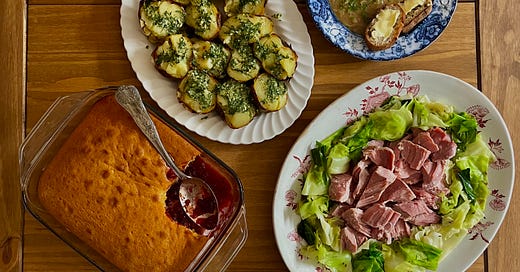



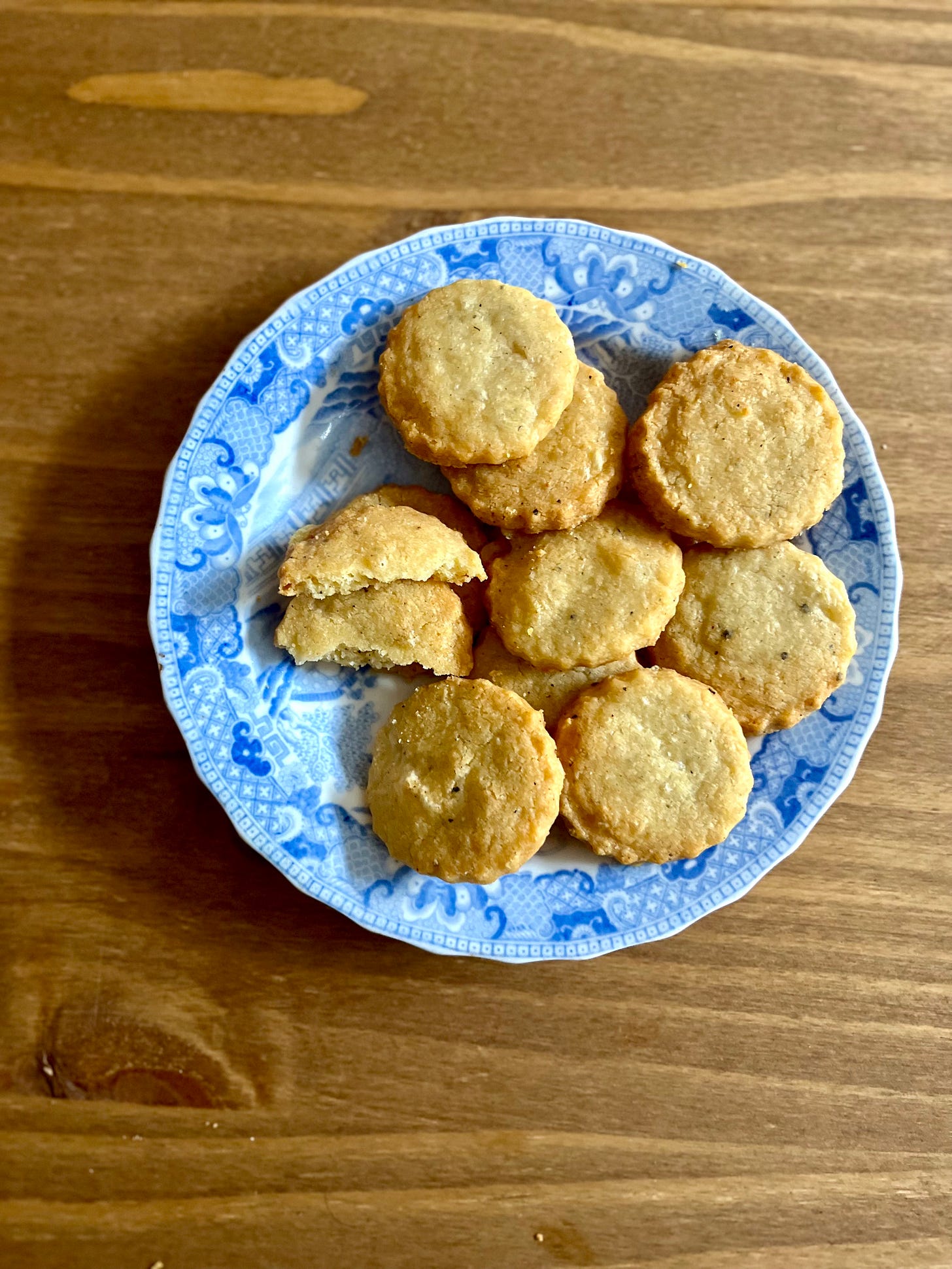
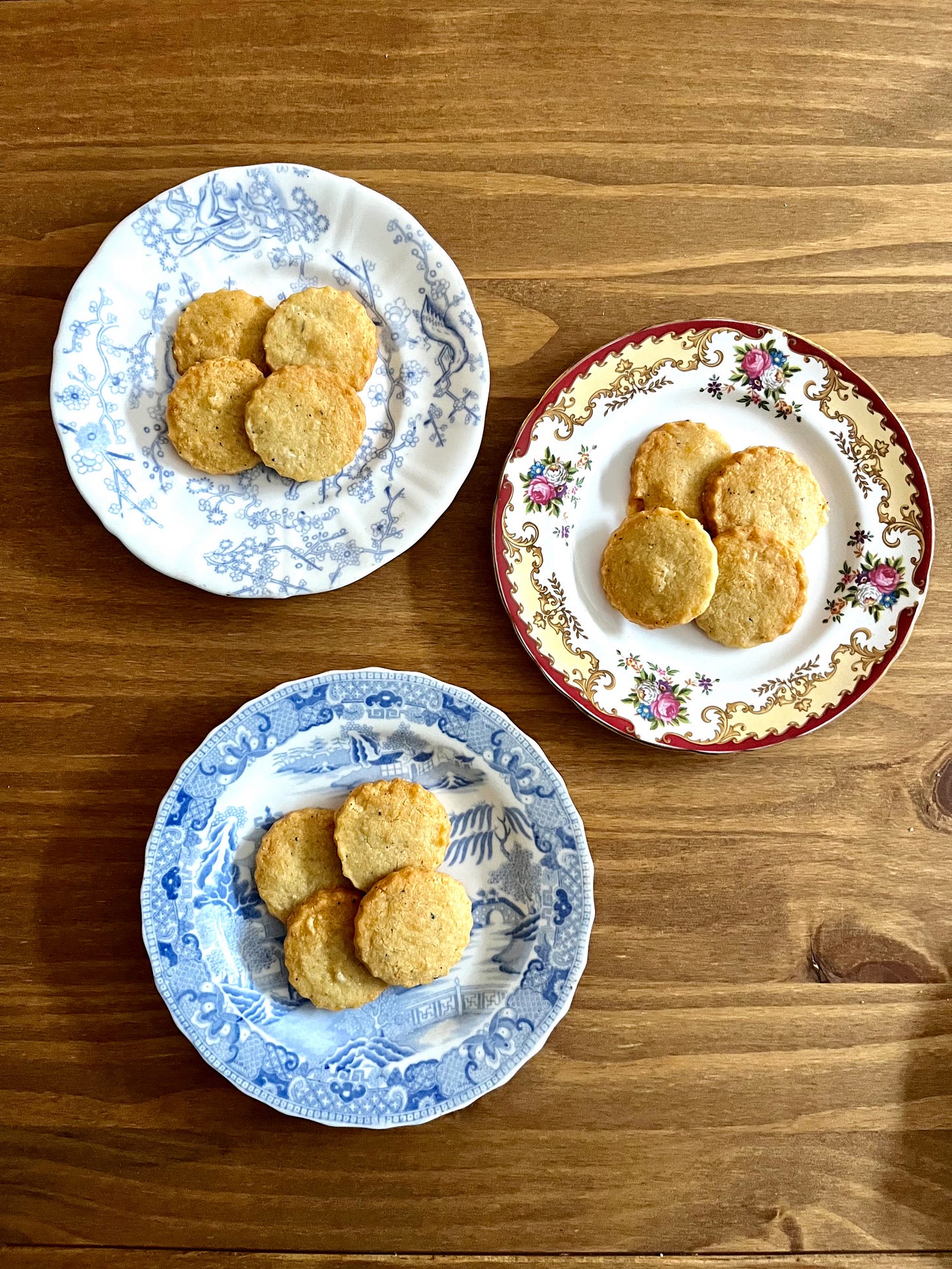
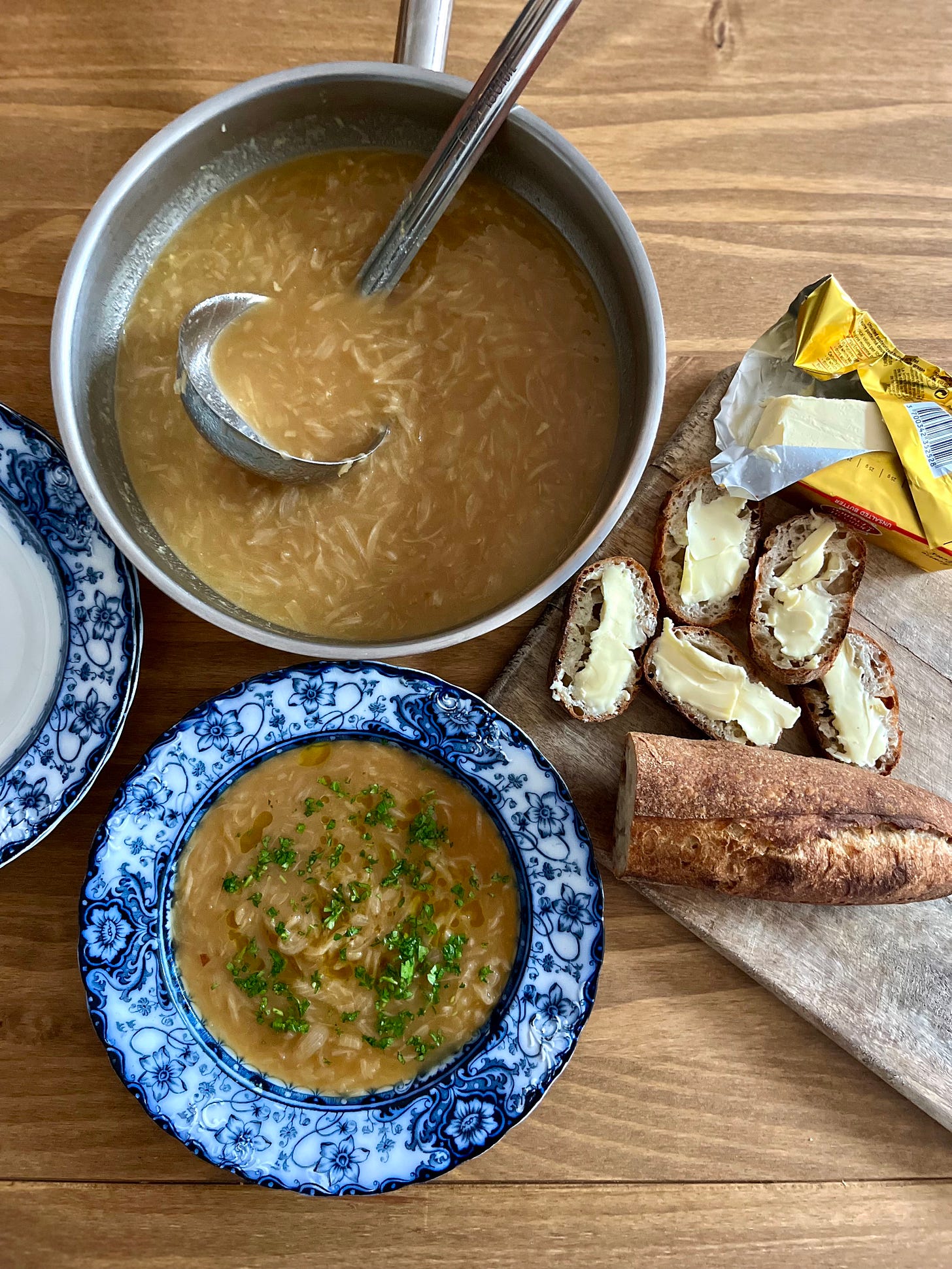
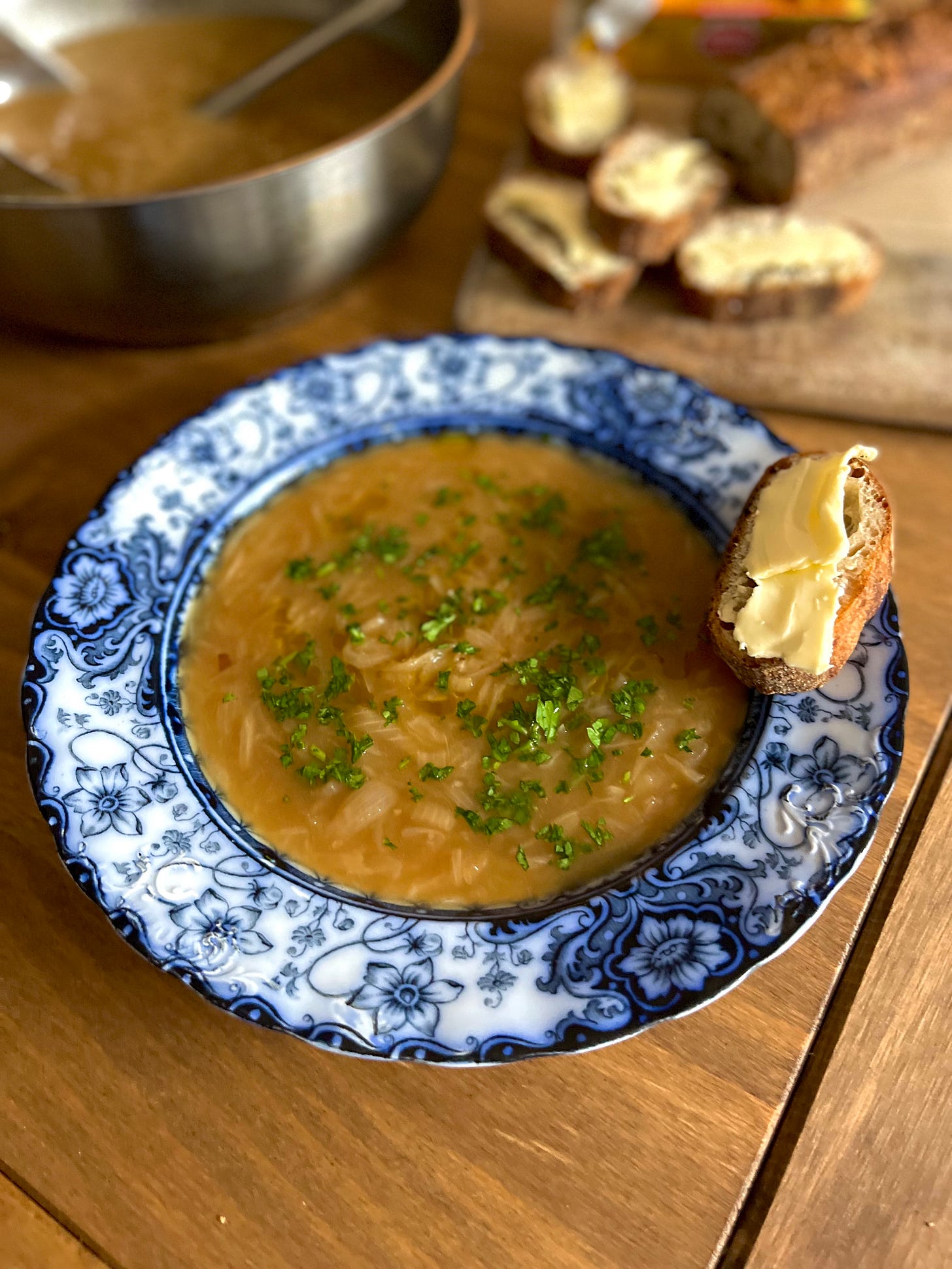


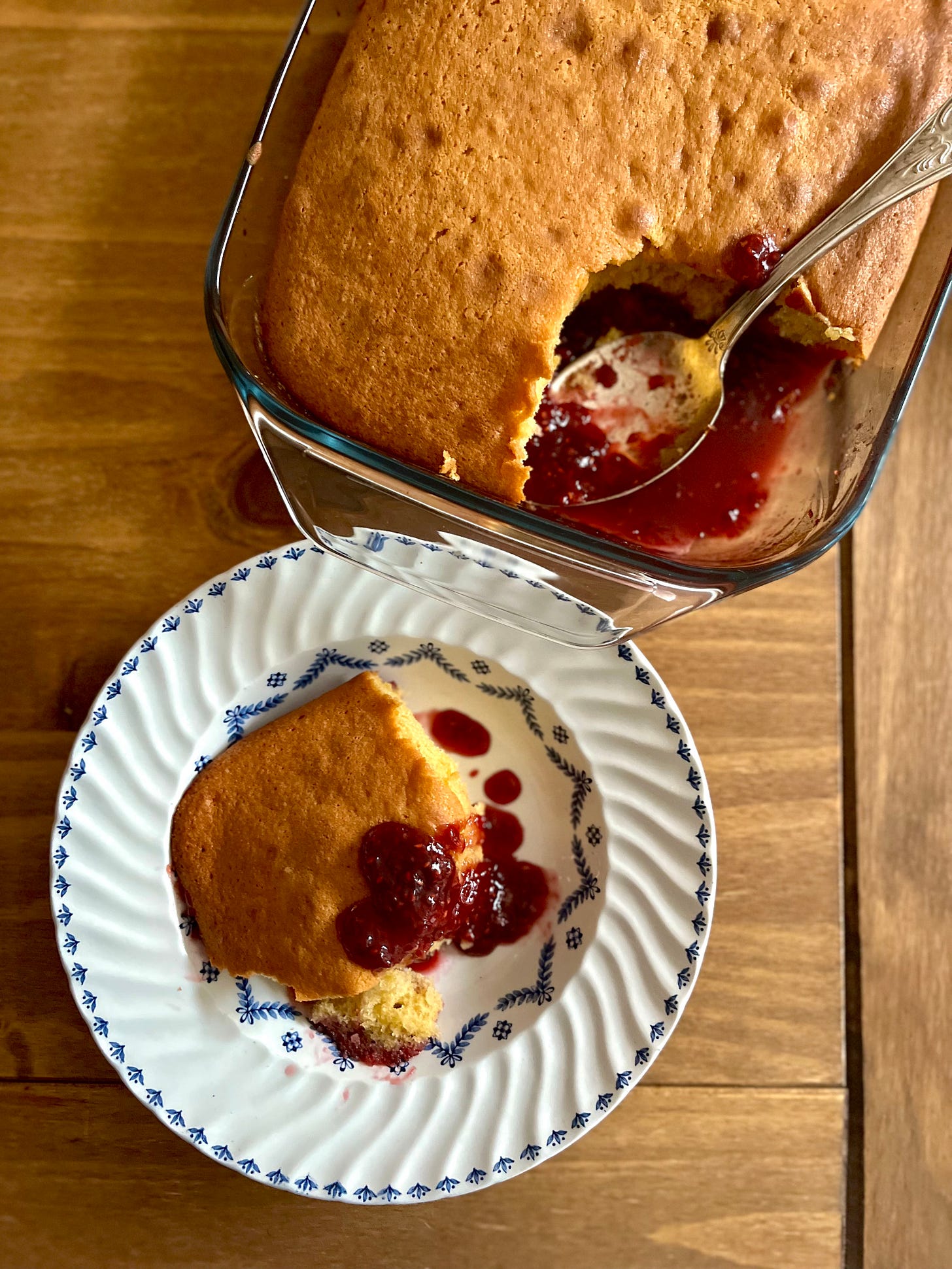


This felt like a hug :) Love the way nostalgia and autumn inspired the menu!